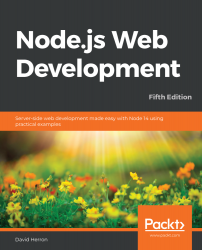As described in Chapter 2, Setting up Node.js, npm is a package management and distribution system for Node.js. It has become the de facto standard for distributing modules (packages) for use with Node.js. Conceptually, it's similar to tools such as apt-get (Debian), rpm/yum (Red Hat/Fedora), MacPorts/Homebrew (macOS), CPAN (Perl), or PEAR (PHP). Its purpose is to publish and distributing Node.js packages over the internet using a simple command-line interface. In recent years, it has also become widely used for distributing front-end libraries like jQuery and Bootstrap that are not Node.js modules. With npm, you can quickly find packages to serve specific purposes, download them, install them, and manage packages you've already installed.
The npm application extends on the package format for Node.js, which in turn is largely based on the CommonJS package specification. It uses the same package.json file that's supported...



